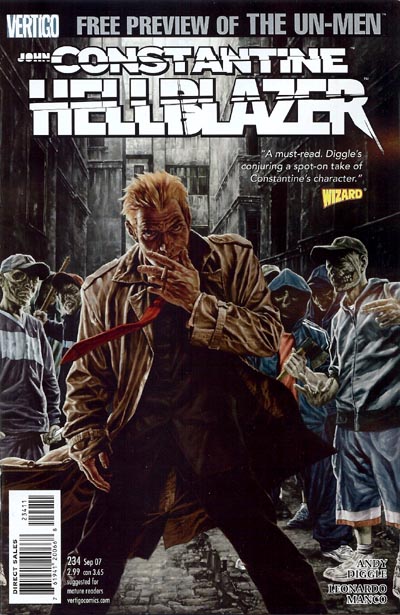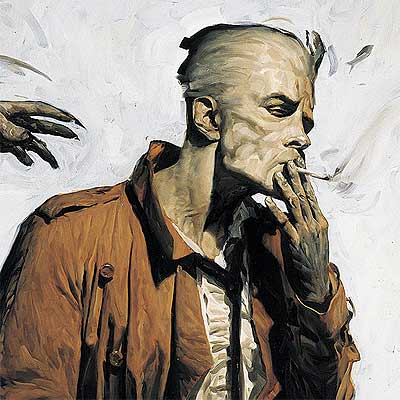
Great Science Fiction and Fantasy Writers Who Never Wrote Sequels or Trilogies
Sometimes it seems like science fiction, and especially fantasy, are genres that lend themselves exclusively to trilogies and long-running series. But some of the greatest writers in speculative fiction have only written standalone novels, not series or trilogies.
Here are some of the greatest writers in the genre who never wrote sequels to their work. Note: This is by no means going to be an exhaustive list. Especially given how many Golden Age authors only wrote standalone books, we could be here all day if we tried to list every author who wrote nothing but standalones. Feel free to list your own favorites in the comments. Also, note that we're not including authors who wrote multiple books in the same universe.
Top image: Cover art for Philip K. Dick's The Crack in Space by Chris Moore
Alfred BesterThe author of The Demolished Man and The Stars My Destination only wrote half a dozen or so novels, and most of them were serialized in magazines prior to being published in book form. And as far as we're aware, he never returned to any of his corporate-dominated, dystopian, space-faring or telepath-dominated futures for more than one book.
Bruce Sterling
He's the great iconoclast of science fiction, so it's not surprising that Sterling has resisted the temptation to revisit his worlds — lots of people expected a sequel to Schismatrix, for example. (Although Schismatrix, itself, was a follow-up to a collection of short stories,Crystal Express, so that's an edge case.) In the afterword to The Difference Engine, he and collaborator William Gibson write, "We didn't lift a finger to make a steampunk scene happen; we never wrote a sequel, nor will we."
H.G. Wells
With novels like The Invisible Man, War of the Worlds and The Time Machine, Wells invented much of the bedrock of science fiction — and even though he was astonishingly prolific well into the 20th century, Wells never felt the need to revisit his old characters or stories. He never wrote a follow-up to The Time Machine or the story of a second Martian invasion. Science fiction's great originator kept putting out originals, throughout his life.
 George Orwell
George OrwellArguably speculative most famous political novelist, Orwell mostly wrote semi-autobiographical novels, and only turned to speculative fiction at the very end of his career. And we're probably all better off that he never got around to writing Nineteen Eighty Five before he died in 1950.
One of the most acclaimed — and prolific — science fiction authors of all time, Dick returned to certain themes of alienation, surveillance and madness over and over again. But he never returned to the same characters or setting for more than one book — although Dick did work on a sequel to his acclaimed novel The Man in the High Castle, and a few chapters were included in the 1995 book The Shifting Realities of Philip K. Dick.Cover art by Sparth.
 Maureen F. McHugh
Maureen F. McHughShe's only published four novels and a number of short stories to date, but she's one of the most acclaimed authors out there. She's the master of creating unusual settings, like China Mountain Zhang's China-dominated 22nd century, or Half the Day is Night's submerged city of Julia. But as far as we know, she's never returned to one of those settings for a second look.
 Max Barry
Max BarryOne of our favorite newer writers, Barry often writes about the same preoccupations, including corporatocracy and out-of-control technology. But thus far, his four novels haven't intersected in any meaningful fashion, and he's come up with fresh dystopias to drive us to distraction.
The man who gave us Sturgeon's Law was far from prolific, but all of his novels (and his many short stories) remain a horrifying look into supreme weirdness. His books includeMore Than Human, a disturbing look at post-humanity, and The Dreaming Jewelsand The Cosmic Rape, which include truly alien life forms coming to Earth. Sturgeon's books each remain one of a kind, which helped him achieve a much better success rate than his eponymous law would indicate.
 Clifford D. Simak
Clifford D. SimakSpeaking of weird alien life forms... this is the man who gave us the weird bowling balls that come down and start buying up our planet, in They Walked Like Men. Simak wrote a ton of weird novels from the late 1940s through the early 1980s, but we're pretty sure he never went back to the same well twice. Instead, he deepened his themes of robot consciousness, time travel, and strange explorations.
Best known for giving us the word "robot" inRossum's Universal Robots, this Czech playwright and satirist also wrote The War With The Newts, which we celebrated recently. Like Orwell, he used science fiction to illuminate the troubling issues of his time, and he predicted weapons of mass destruction as well as our hyper-consumerist society. But he never wrote more than one work about the same imaginary future.
 J.G. Ballard
J.G. BallardThis bastion of the New Wave wrote a slew of hard-to-categorize novels, including Crashand The Concrete Island. But apart from one collection of linked short stories, he never wrote twice about the same setting or characters. (Thanks for the suggestion, Tim!)
The writer of The Young Ones andBlackadder wrote a whole bunch of satirical novels in the 1990s, most of which were science fiction, and we've praised his work before. In each novel, Elton takes on another off-kilter thought experiment, plays with it, and then tosses it aside to find another odd premise.
 Fredric Brown
Fredric BrownThe prolific author of mysteries and mainstream fiction also wrote five well-received science fiction novels, includingMartians Go Home — but he never wrote a shared-universe series or a sequel to any of his books.
Additional reporting by Marykate Jasper and Gordon M. Jackson.







 New York City is covered in romantic qualities. Be them personal experiences romping through the city in the middle of the night with a cute boy you met on the elevator, absorbing yourself in a different culture around every corner, or because you just straight up watch too many films without having ever visited one of the five boroughs. New York is a city of dreams, schemers, and downtrodden, but each person who experiences the island knows the pull and excitement of this crazy-making place.
New York City is covered in romantic qualities. Be them personal experiences romping through the city in the middle of the night with a cute boy you met on the elevator, absorbing yourself in a different culture around every corner, or because you just straight up watch too many films without having ever visited one of the five boroughs. New York is a city of dreams, schemers, and downtrodden, but each person who experiences the island knows the pull and excitement of this crazy-making place.
 Welcome back to Junkfood Cinema; scientifically proven. This is the weekly internet column with a permanent case of the munchies. Every Friday I serve up a jive cinematic turkey which I then proceed to slap all up and down with snark. But I temper that by showering it with sweet, sweet affection because I am in fact a lover of bad movies. Wow, is it hot in here or is it just…wholly inappropriate. To complete this weird little combo plate, I will then pair the film with a themed snack food item that will judo kick you in the intestines the way the movie backhands your brain.
Welcome back to Junkfood Cinema; scientifically proven. This is the weekly internet column with a permanent case of the munchies. Every Friday I serve up a jive cinematic turkey which I then proceed to slap all up and down with snark. But I temper that by showering it with sweet, sweet affection because I am in fact a lover of bad movies. Wow, is it hot in here or is it just…wholly inappropriate. To complete this weird little combo plate, I will then pair the film with a themed snack food item that will judo kick you in the intestines the way the movie backhands your brain.

 As I argued in my
As I argued in my 











